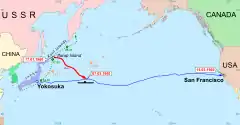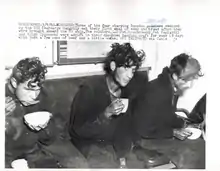Self-propelled barge T-36
The self-propelled barge T-36 was a Soviet barge of the Project 306 type. Its waterline length is 17.3 m, width is 3.6 m, depth is 2 m, draft is 1.2 m. Tonnage is 100 tons, barge has two engines, speed is 9 knots.[1]
 | |
| Date | January 17th, 1960 |
|---|---|
| Duration | 49 days |
| Non-fatal injuries | 4 |
Prehistory
In December 1959, all six of the self-propelled barges attached to the garrison of the Iturup island, were beached in order to wait out the period of winter storms and perform planned repairs. Ten-day emergency rations that were normally stored aboard, were sent to the depot. Shortly before January 17, 1960 the command has been alerted of a final supply ship's late arrival, and two of the six barges were dragged back to the water. Both received 1.5 tonnes of diesel fuel and, on January 15, a three-day supplies of water and food. Both, T-36 and T-97, were moored to a floating barrel approximately 500 feet offshore.[2]
49-days long drift in the Pacific
Shortly after midnight of January 17, 1960, the barges were hit by a severe storm, accompanied with hurricane-force winds. The tackle was torn and the crew, junior sergeant Askhat Ziganshin (Russian: Асхат Рахимзянович Зиганшин, Tatar: Cyrillic Әсхәт Рәхимҗан улы Җиһаншин, Latin Äsxät Räximcan ulı Cihanşin), and three privates, Filipp Poplavsky (Russian: Филипп Григорьевич Поплавский), Anatoly Kryuchkovsky (Russian: Анатолий Фёдорович Крючковский), and Ivan Fedotov (Russian: Иван Ефимович Федотов), started the barge's engines in attempt to stay away from the rocks. Weighing anchor away from the shore proved impossible due to poor visibility and strong winds; when, after 40–50 minutes the wind pushed the barge too close to the shore, the engines were started again in order to navigate further away from it. This sequence repeated a few more times. Fighting with the storm continued for over ten hours.
Eventually the eye of the storm passed over the island, and the wind reversed direction, this time pushing the barge away from the shore. The crew decided to run the barge aground, but when they attempted to do so, around 10pm, the engines ran out of fuel and stopped. The wind dragged the barge out of the lagoon and into the open ocean. The crew of T-97 had better luck and managed to successfully run their barge aground.
The garrison command was aware of the crew struggle with the hurricane, but then radio communications ceased, as the barge's transmitter was rendered inoperable by the storm. As the storm subsided, search and rescue crew of fifteen soldiers was deployed to sweep the seashore. The wreckage discovered by them, which included a lifesaver and remnants of the wooden coal storage box, both marked with the barge's number, confirmed the suspicion that the barge has been sunk by the hurricane, and its crew perished. After the conclusion of search efforts, formal missing person notifications have been sent to the families of the crew.
Meanwhile the uncontrolled T-36, lacking any means of communication, started its 49-day long drift, until the U.S. aircraft carrier Kearsarge picked up them on 7 March[3] in stormy waters 1,200 miles off Wake Island.
There was not enough food on the barge: one loaf of bread and a bucket of potatoes that got scattered around by storm and ended up sodden in diesel fuel. The crew eventually ate their leather belts, wristlets, leather parts of their garmon and leather boots in attempts to quell the hunger. While their original water supply, a 2-bucket-worth tank, has been destroyed by the storm, a significant amount — over 120 litres (32 US gal) — of fresh water, "red with rust, tasting like metal", was available in the engines' cooling system. After burning random papers, rags, and their wooden beds, the crew eventually resorted to using tires that served as the barge's fenders, for fuel.
Approximately 40 days into their journey, they spotted a passing ship, but attempts to attract its attention failed; in the following days, two more ships passed by without noticing them. Finally, around 3pm (local time) on March 7,[3] they were been spotted by two S2Fs launched by the Kearsarge, and consequently rescued.
The drift of Askhat "Victor" Ziganshin's crew were noticed by the worldwide press. Returning to the USSR, the crew had popularity close to that of cosmonauts, and took a major role in Soviet popular culture.[4] Soviet government expressed gratitude to the Kearsarge for its gesture;[5] the crew was soon returned home, first traveling to Paris on the RMS Queen Mary cruise liner, and then flying to the USSR, as doctors recommended against taking a transatlantic flight.
 Filipp Poplavsky (left) telling their story. Askhat Ziganshin (center) listens.
Filipp Poplavsky (left) telling their story. Askhat Ziganshin (center) listens. Kryuchkovsky, Poplavsky, Ziganshin consuming some soup and bread shortly after being rescued.
Kryuchkovsky, Poplavsky, Ziganshin consuming some soup and bread shortly after being rescued. Ivan Fedotov drinking coffee after being rescued. March 9, 1960.
Ivan Fedotov drinking coffee after being rescued. March 9, 1960. Askhat Ziganshin is being shaved for the first time in 49 days.
Askhat Ziganshin is being shaved for the first time in 49 days. Filipp Poplavsky getting a haircut for the first time in 49 days.
Filipp Poplavsky getting a haircut for the first time in 49 days. Fefotov, Ziganshin, Poplavsky on the deck of USS Kearsarge. March 14, 1960
Fefotov, Ziganshin, Poplavsky on the deck of USS Kearsarge. March 14, 1960 After arrival at Moscow. March 1960. Left to right: Ivan Fedotov, Askhat Ziganshin, head of Political Directorate of the Soviet Army general Filipp Golikov, Filipp Poplavsky, Anatoly Kryuchkovsky
After arrival at Moscow. March 1960. Left to right: Ivan Fedotov, Askhat Ziganshin, head of Political Directorate of the Soviet Army general Filipp Golikov, Filipp Poplavsky, Anatoly Kryuchkovsky
49-days long drift in Soviet pop-culture
The name of Askhat Ziganshin was well known in the pop-culture of the Soviet Union in the 1960s as Askhat "Ate-His-Boot" Ziganshin.[6]
Childish rhyme:
Юрий Гагарин
Зиганшин-татарин
Никита Хрущёв
А ты кто будешь таков?
Yuri Gagarin
Ziganshin the Tatar
Nikita Khrushchev
And who are you?
References
- (in Russian)
- Sergey Babakov (1999). ""Героем я себя никогда не считал"" [«I never considered myself a hero»]. Зеркало недели (in Russian) (11). Kyiv (published 1999-03-19). Archived from the original on 2020-06-25.
- "Deck Log Book of the U.S.S. Kearsarge CVS-33 — March 1960".
- (in Russian) Смена: 14.06.06. Асхат Зиганшин: «Кожаные сапоги мне дарят до сих пор»
- "USS Kearsarge Rescues Soviet Soldiers, 1960". History.navy.mil. Retrieved 2014-04-22.
- (in Russian)
Videos
Publications
- "Four Russians Adrift 49 Days Saved by U.S. Carrier in Pacific". The New York Times. New York: The New York Times Company. 1960-03-09. p. 1. ISSN 0362-4331.
- "Red Soldiers Recovering After Drifting 49 Days". The Honolulu Advertiser. Honolulu, Hawaii. 1960-03-09. p. 4 – via newspapers.com.
- "4 Russians Saved After Drifting 7 Weeks; Ate Shoes to Stay Alive". Chattanooga Daily Times. Chattanooga, Tennessee. 1960-03-09. p. 1 – via newspapers.com.
- "4 Russians Saved After Drifting 7 Weeks; Ate Shoes to Stay Alive". Chattanooga Daily Times. Chattanooga, Tennessee. 1960-03-09. p. 10 – via newspapers.com.
- "4 Rescued Soviet Seamen To Arrive in U.S. Today". Corpus Christi Times. Corpus Christi, Texas. 1960-03-15. p. 9 – via NewspaperArchive.com.
- "For Rescued Red Sailors Reach S.F." Honolulu Star-Bulletin. Honolulu, Hawaii. 1960-03-15. p. 2 – via newspapers.com.
- "Moscow Hails Rescue Army Paper Notes U.S. Navy's Saving 4 Soldiers in Pacific". The New York Times. New York: The New York Times Company. 1960-03-13. p. 4. ISSN 0362-4331.
- "Russians Thank U.S. Sailors". The New York Times. New York: The New York Times Company. 1960-03-15. p. 12. ISSN 0362-4331.
- Max Frankel (1960-03-15). "U.S. Navy Rescue Pleases Moscow ; Finding of 4 Russians Adrift in Pacific Brings Wave of Goodwill to Americans". The New York Times. New York: The New York Times Company. p. 12. ISSN 0362-4331.
- Lawrence E. Davies (1960-03-16). "San Francisco Greets Four Russians Saved at Sea; 4 Soviet Sailors Welcomed in U.S." The New York Times. New York: The New York Times Company. p. 13. ISSN 0362-4331.
- "Khrushchev Halls U.S. For Rescue of 4 Sailors". The New York Times. New York: The New York Times Company. 1960-03-16. p. 17. ISSN 0362-4331.
- "4 Soviet Sailors Here; Men Rescued by U.S. Navy to Rest at Glen Cove". The New York Times. New York: The New York Times Company. 1960-03-18. p. 54. ISSN 0362-4331.
- "Soviet Sailors in Paris; Four Rescued by Americans Flying to Moscow Today". The New York Times. New York: The New York Times Company. 1960-03-29. p. 13. ISSN 0362-4331.
- "Moscow Lionizes 4 Rescued by U.S. Ship; Seamen Are Hailed on Return as New Communist Men". The New York Times. New York: The New York Times Company. 1960-03-29. p. 9. ISSN 0362-4331.
- Yevgeni Bugayenko, Stanislav Kalinichev, Alexander Turundayevsky (February 1981). "The Magnificent Four: Two Decades After". Soviet Life. pp. 48–54.CS1 maint: multiple names: authors list (link)
- Public papers of the Presidents of the United States. Dwight D. Eisenhower 1960-61. Federal Register Division, National Archives and Records Service, General Services Administration. 1960-12-31. pp. 310–311.
- Alexey Timofeychev (2018-08-08). "49 days at sea: When the U.S. Navy saved Soviet soldiers in distress". Russia Beyond.
- Ruslan Budnik (2018-08-28). "49 days Adrift – USS Kearsarge Saved Soviet Sailors". War History Online.
- "USS Kearsarge Rescues Soviet Soldiers, 1960". Naval History and Heritage Command. 2018-05-04.